Shaojun Wang
Sentinel: Attention Probing of Proxy Models for LLM Context Compression with an Understanding Perspective
May 29, 2025Abstract:Retrieval-augmented generation (RAG) enhances large language models (LLMs) with external context, but retrieved passages are often lengthy, noisy, or exceed input limits. Existing compression methods typically require supervised training of dedicated compression models, increasing cost and reducing portability. We propose Sentinel, a lightweight sentence-level compression framework that reframes context filtering as an attention-based understanding task. Rather than training a compression model, Sentinel probes decoder attention from an off-the-shelf 0.5B proxy LLM using a lightweight classifier to identify sentence relevance. Empirically, we find that query-context relevance estimation is consistent across model scales, with 0.5B proxies closely matching the behaviors of larger models. On the LongBench benchmark, Sentinel achieves up to 5$\times$ compression while matching the QA performance of 7B-scale compression systems. Our results suggest that probing native attention signals enables fast, effective, and question-aware context compression. Code available at: https://github.com/yzhangchuck/Sentinel.
CHOrD: Generation of Collision-Free, House-Scale, and Organized Digital Twins for 3D Indoor Scenes with Controllable Floor Plans and Optimal Layouts
Mar 15, 2025Abstract:We introduce CHOrD, a novel framework for scalable synthesis of 3D indoor scenes, designed to create house-scale, collision-free, and hierarchically structured indoor digital twins. In contrast to existing methods that directly synthesize the scene layout as a scene graph or object list, CHOrD incorporates a 2D image-based intermediate layout representation, enabling effective prevention of collision artifacts by successfully capturing them as out-of-distribution (OOD) scenarios during generation. Furthermore, unlike existing methods, CHOrD is capable of generating scene layouts that adhere to complex floor plans with multi-modal controls, enabling the creation of coherent, house-wide layouts robust to both geometric and semantic variations in room structures. Additionally, we propose a novel dataset with expanded coverage of household items and room configurations, as well as significantly improved data quality. CHOrD demonstrates state-of-the-art performance on both the 3D-FRONT and our proposed datasets, delivering photorealistic, spatially coherent indoor scene synthesis adaptable to arbitrary floor plan variations.
Self-Enhanced Reasoning Training: Activating Latent Reasoning in Small Models for Enhanced Reasoning Distillation
Feb 18, 2025Abstract:The rapid advancement of large language models (LLMs) has significantly enhanced their reasoning abilities, enabling increasingly complex tasks. However, these capabilities often diminish in smaller, more computationally efficient models like GPT-2. Recent research shows that reasoning distillation can help small models acquire reasoning capabilities, but most existing methods focus primarily on improving teacher-generated reasoning paths. Our observations reveal that small models can generate high-quality reasoning paths during sampling, even without chain-of-thought prompting, though these paths are often latent due to their low probability under standard decoding strategies. To address this, we propose Self-Enhanced Reasoning Training (SERT), which activates and leverages latent reasoning capabilities in small models through self-training on filtered, self-generated reasoning paths under zero-shot conditions. Experiments using OpenAI's GPT-3.5 as the teacher model and GPT-2 models as the student models demonstrate that SERT enhances the reasoning abilities of small models, improving their performance in reasoning distillation.
Dynamic Attention-Guided Context Decoding for Mitigating Context Faithfulness Hallucinations in Large Language Models
Jan 02, 2025Abstract:Large language models (LLMs) often suffer from context faithfulness hallucinations, where outputs deviate from retrieved information due to insufficient context utilization and high output uncertainty. Our uncertainty evaluation experiments reveal a strong correlation between high uncertainty and hallucinations. We hypothesize that attention mechanisms encode signals indicative of contextual utilization, validated through probing analysis. Based on these insights, we propose Dynamic Attention-Guided Context Decoding (DAGCD), a lightweight framework that integrates attention distributions and uncertainty signals in a single-pass decoding process. Experiments across QA datasets demonstrate DAGCD's effectiveness, achieving significant improvements in faithfulness and robustness while maintaining computational efficiency.
Rethinking Layer Removal: Preserving Critical Components with Task-Aware Singular Value Decomposition
Dec 31, 2024Abstract:Layer removal has emerged as a promising approach for compressing large language models (LLMs) by leveraging redundancy within layers to reduce model size and accelerate inference. However, this technique often compromises internal consistency, leading to performance degradation and instability, with varying impacts across different model architectures. In this work, we propose Taco-SVD, a task-aware framework that retains task-critical singular value directions, preserving internal consistency while enabling efficient compression. Unlike direct layer removal, Taco-SVD preserves task-critical transformations to mitigate performance degradation. By leveraging gradient-based attribution methods, Taco-SVD aligns singular values with downstream task objectives. Extensive evaluations demonstrate that Taco-SVD outperforms existing methods in perplexity and task performance across different architectures while ensuring minimal computational overhead.
Learning to Adapt to Low-Resource Paraphrase Generation
Dec 22, 2024Abstract:Paraphrase generation is a longstanding NLP task and achieves great success with the aid of large corpora. However, transferring a paraphrasing model to another domain encounters the problem of domain shifting especially when the data is sparse. At the same time, widely using large pre-trained language models (PLMs) faces the overfitting problem when training on scarce labeled data. To mitigate these two issues, we propose, LAPA, an effective adapter for PLMs optimized by meta-learning. LAPA has three-stage training on three types of related resources to solve this problem: 1. pre-training PLMs on unsupervised corpora, 2. inserting an adapter layer and meta-training on source domain labeled data, and 3. fine-tuning adapters on a small amount of target domain labeled data. This method enables paraphrase generation models to learn basic language knowledge first, then learn the paraphrasing task itself later, and finally adapt to the target task. Our experimental results demonstrate that LAPA achieves state-of-the-art in supervised, unsupervised, and low-resource settings on three benchmark datasets. With only 2\% of trainable parameters and 1\% labeled data of the target task, our approach can achieve a competitive performance with previous work.
Planning with Large Language Models for Conversational Agents
Jul 04, 2024Abstract:Controllability and proactivity are crucial properties of autonomous conversational agents (CAs). Controllability requires the CAs to follow the standard operating procedures (SOPs), such as verifying identity before activating credit cards. Proactivity requires the CAs to guide the conversation towards the goal during user uncooperation, such as persuasive dialogue. Existing research cannot be unified with controllability, proactivity, and low manual annotation. To bridge this gap, we propose a new framework for planning-based conversational agents (PCA) powered by large language models (LLMs), which only requires humans to define tasks and goals for the LLMs. Before conversation, LLM plans the core and necessary SOP for dialogue offline. During the conversation, LLM plans the best action path online referring to the SOP, and generates responses to achieve process controllability. Subsequently, we propose a semi-automatic dialogue data creation framework and curate a high-quality dialogue dataset (PCA-D). Meanwhile, we develop multiple variants and evaluation metrics for PCA, e.g., planning with Monte Carlo Tree Search (PCA-M), which searches for the optimal dialogue action while satisfying SOP constraints and achieving the proactive of the dialogue. Experiment results show that LLMs finetuned on PCA-D can significantly improve the performance and generalize to unseen domains. PCA-M outperforms other CoT and ToT baselines in terms of conversation controllability, proactivity, task success rate, and overall logical coherence, and is applicable in industry dialogue scenarios. The dataset and codes are available at XXXX.
A Single-Step Non-Autoregressive Automatic Speech Recognition Architecture with High Accuracy and Inference Speed
Jun 13, 2024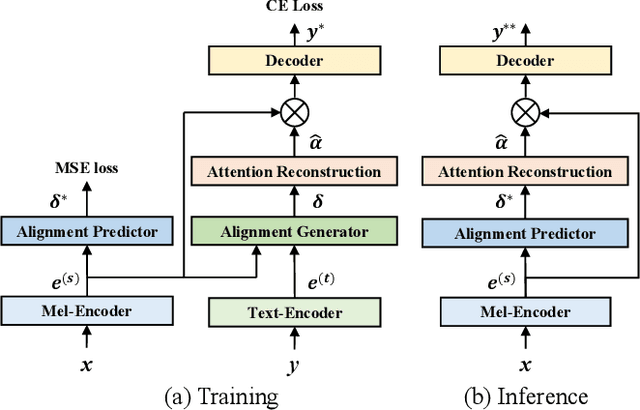
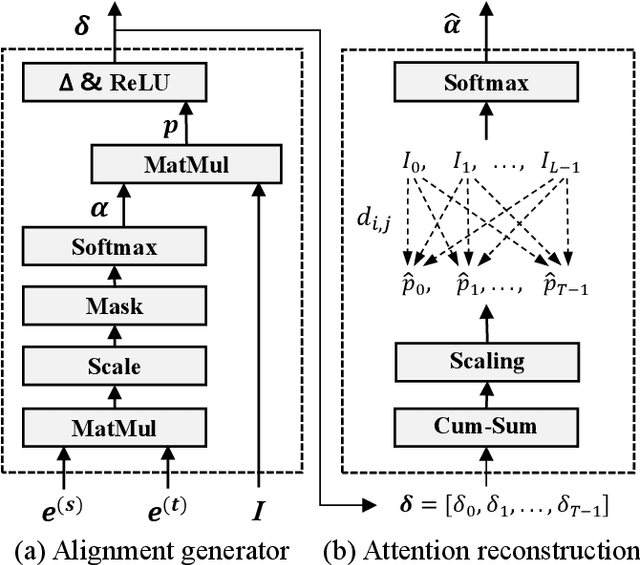
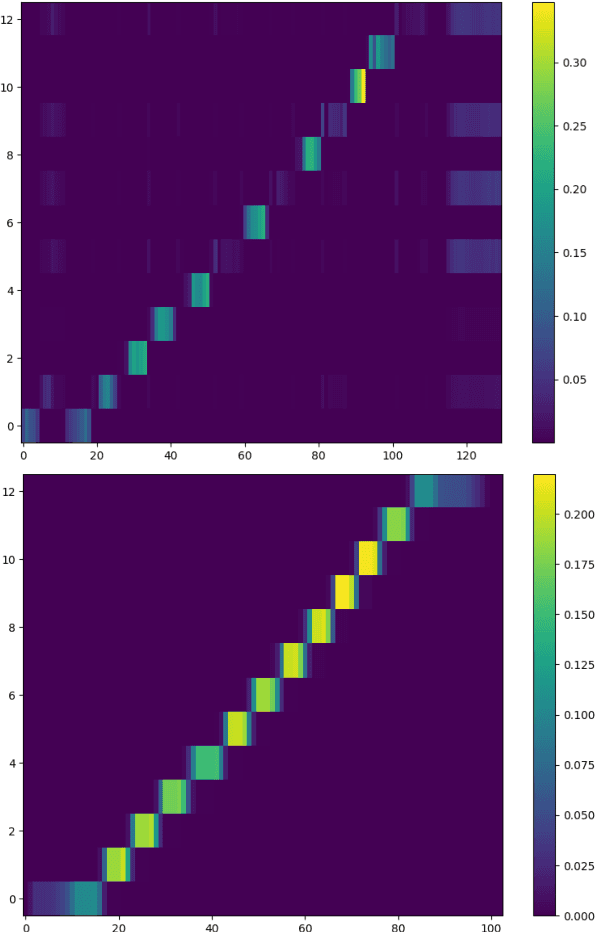
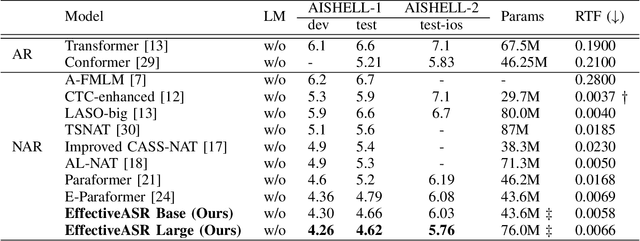
Abstract:Non-autoregressive (NAR) automatic speech recognition (ASR) models predict tokens independently and simultaneously, bringing high inference speed. However, there is still a gap in the accuracy of the NAR models compared to the autoregressive (AR) models. To further narrow the gap between the NAR and AR models, we propose a single-step NAR ASR architecture with high accuracy and inference speed, called EfficientASR. It uses an Index Mapping Vector (IMV) based alignment generator to generate alignments during training, and an alignment predictor to learn the alignments for inference. It can be trained end-to-end (E2E) with cross-entropy loss combined with alignment loss. The proposed EfficientASR achieves competitive results on the AISHELL-1 and AISHELL-2 benchmarks compared to the state-of-the-art (SOTA) models. Specifically, it achieves character error rates (CER) of 4.26%/4.62% on the AISHELL-1 dev/test dataset, which outperforms the SOTA AR Conformer with about 30x inference speedup.
Enhancing Dual-Encoders with Question and Answer Cross-Embeddings for Answer Retrieval
Jun 07, 2022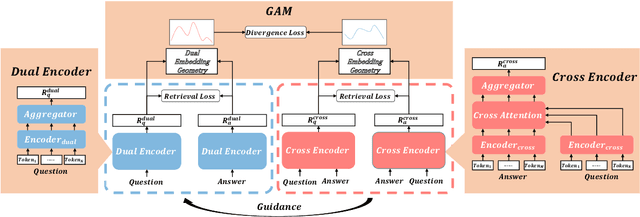

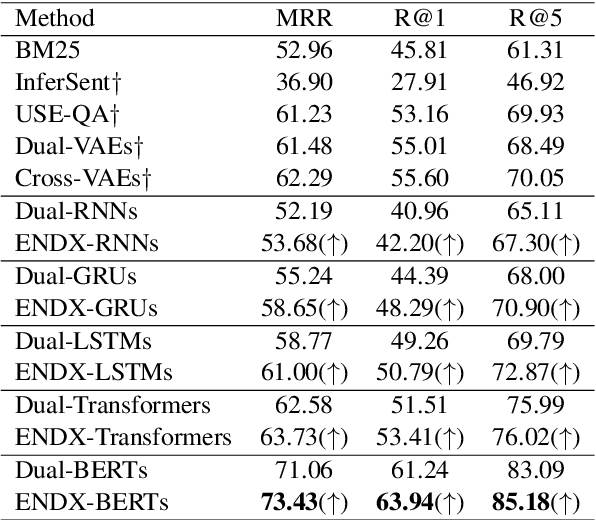
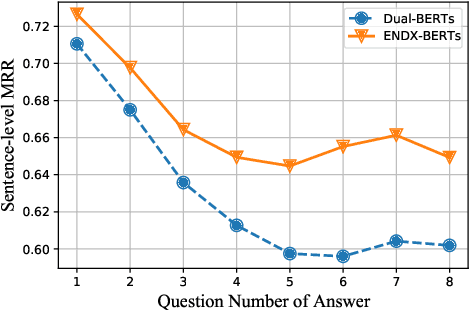
Abstract:Dual-Encoders is a promising mechanism for answer retrieval in question answering (QA) systems. Currently most conventional Dual-Encoders learn the semantic representations of questions and answers merely through matching score. Researchers proposed to introduce the QA interaction features in scoring function but at the cost of low efficiency in inference stage. To keep independent encoding of questions and answers during inference stage, variational auto-encoder is further introduced to reconstruct answers (questions) from question (answer) embeddings as an auxiliary task to enhance QA interaction in representation learning in training stage. However, the needs of text generation and answer retrieval are different, which leads to hardness in training. In this work, we propose a framework to enhance the Dual-Encoders model with question answer cross-embeddings and a novel Geometry Alignment Mechanism (GAM) to align the geometry of embeddings from Dual-Encoders with that from Cross-Encoders. Extensive experimental results show that our framework significantly improves Dual-Encoders model and outperforms the state-of-the-art method on multiple answer retrieval datasets.
Adding Connectionist Temporal Summarization into Conformer to Improve Its Decoder Efficiency For Speech Recognition
Apr 08, 2022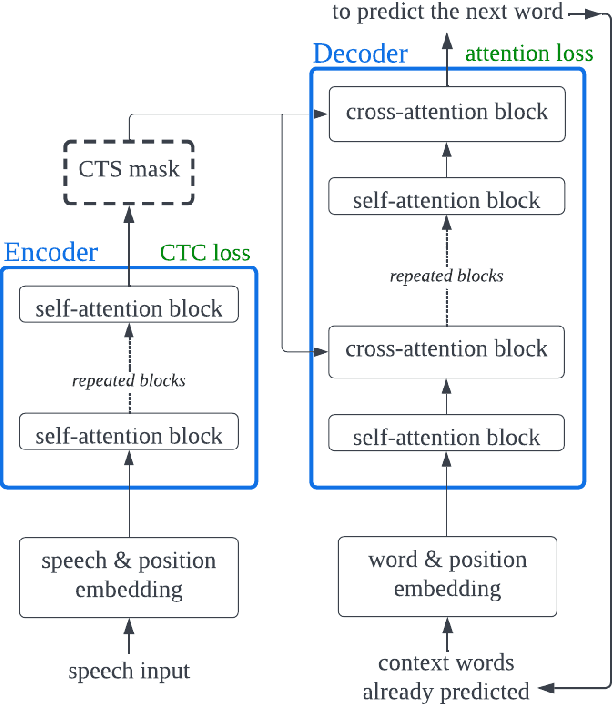
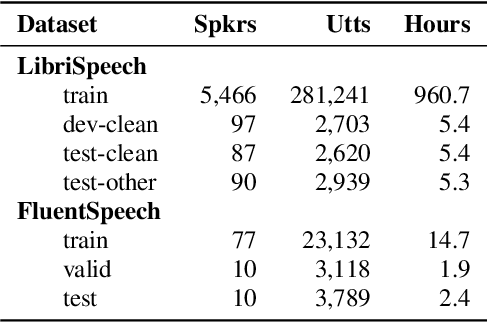
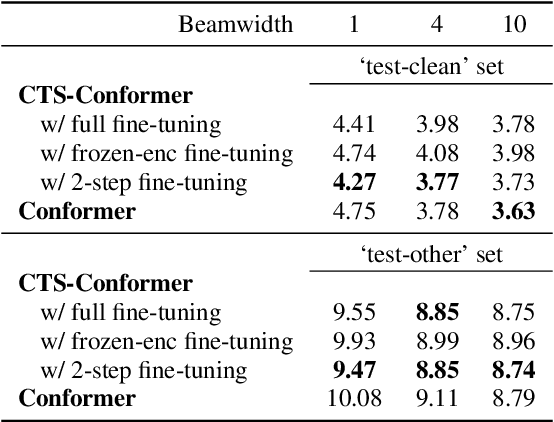
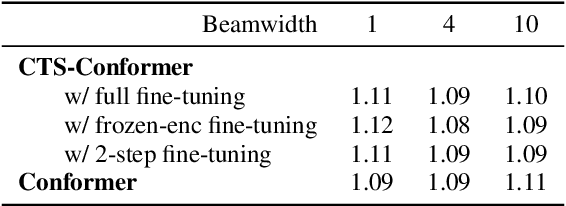
Abstract:The Conformer model is an excellent architecture for speech recognition modeling that effectively utilizes the hybrid losses of connectionist temporal classification (CTC) and attention to train model parameters. To improve the decoding efficiency of Conformer, we propose a novel connectionist temporal summarization (CTS) method that reduces the number of frames required for the attention decoder fed from the acoustic sequences generated by the encoder, thus reducing operations. However, to achieve such decoding improvements, we must fine-tune model parameters, as cross-attention observations are changed and thus require corresponding refinements. Our final experiments show that, with a beamwidth of 4, the LibriSpeech's decoding budget can be reduced by up to 20% and for FluentSpeech data it can be reduced by 11%, without losing ASR accuracy. An improvement in accuracy is even found for the LibriSpeech "test-other" set. The word error rate (WER) is reduced by 6\% relative at the beam width of 1 and by 3% relative at the beam width of 4.
 Add to Chrome
Add to Chrome Add to Firefox
Add to Firefox Add to Edge
Add to Edge